Geologists estimate that between 1400 and 1800 million years
ago vast sheets of coarse sand were deposited under long since
vanished seas and lakes.
Since being exposed the sandstone that formed from this, the Kombolgie
sandstone formation, has slowly worn away.
Faults in the 400 metre thick Kombolgie sandstone have eroded into
crevices, gullies, caves and gorges.
During the age of the dinosaurs (140 million years ago) shallow
seas spread across the area, eroding the sandstone into sea cliffs
(now the Arnhem Land escarpment) and islands (outliers).
Burrunggui (Nourlangie Rock) is at the southern tip of the Mt Brockman
outlier.
While parts of the stone country are bare of soil and plants,
patches of vegetation grow where sand has collected in cracks and
gullies.
Conditions change around the scree slopes below stone country.
Growing in these lowlands is savannah grassland and open woodland.
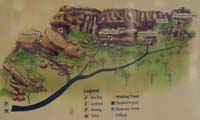
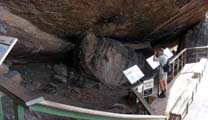
Aboriginal people have been coming home to the Anbangbang shelter
for the last 6'000 years.
Occasional use dates further back to 20'000 years, when the climate
of the area was drier and food more scarce.
Over time objects discarded by people have built up the floor of
the shelter.
Archaeological excavations have revealed organic objects not usually
preserved in the hot, wet climate of northern Australia, safe in
the dryness of this shelter.
The paintings in this gallery and the nearby Nabulwinjbulwinj
were painted by Nayombolmi, also known as Barramundi Charlie.
He returned to repaint these in 1964, shortly before he passed
away.
In 1962, before Nayombolmi's work, British naturalist Sir David
Attenborough had photographed this gallery; those photographs show
paintings much more faded than the ones you now see.
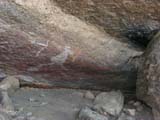
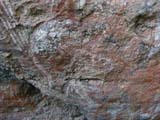
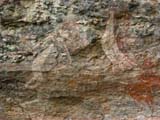
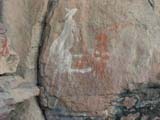
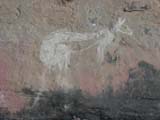
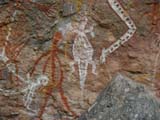
Some different styles have been used here.
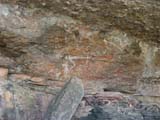
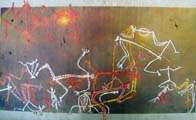
At the gallery some traditional dance scenes can be seen.
The sign explains that the steps and movements depend on the meaning
of the ceremony, the part played by the dancer, the rhythm of
the clapping sticks and
didgeridoo.
Dancing added to the life and vigour of most ceremonial events,
making them something to look forward to.
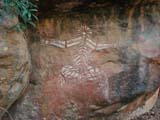
This is Nabulwinjbulwinj.
He is a dangerous spirit who eats females after striking them with
a yam.
Rock art was painted to illustrate an aspect of a story.
This may be a creation story, a hunting experience, or some other
aspect of life.
Some rock art stories are not for everyone to know, some rock art
is sacred and not for everyone to see.
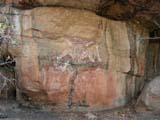
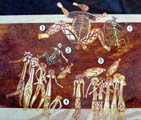
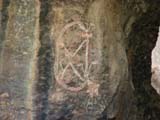
Traditional owners have provided the following information about
this art:
1. Namarrgon the Lightning Man.
He wears his lightning as a band around him connecting his arms,
legs and head.
Stone axes on his knees and elbows make the thunder.
2. Barrginj is Namarrgon's wife.
She and Namarrgon are parents to Aljurr (Aljurr means little lightning)
or the Leichhardt's grasshoppers (Petasida ephippigera).
These grasshoppers come into the country during the early storm
season, when they are said to be looking for Namarrgon.
When Aboriginal people see these grasshoppers in the bush, they
know it is time to seek shelter.
3. Namarndjolg and his sister broke the incest laws on the rock
ledge above this gallery.
He later became Ginga, the great saltwater crocodile.
In Aboriginal culture the incest laws mentioned here are not necessarily
referring to members of the same family, but do extend to community
members with the same cultural responsibility and relationships.
4. Family groups of men and women on their way to a ceremony.
Flecks on the breasts of the two women on the right indicate they
are breast-feeding children.
5. Guluibirr, the saratoga fish, is a popular food fished from
the waterways nearby.
Spiritual ancestors created the landscape, its wildlife, Aboriginal
people and their way of life today.
As stories about these ancestors are retold, important information
about traditional Aboriginal land and laws is passed through generations.
For example, the spectacular electrical storms, which occur here
every year, are a reminder of Namarrgon, the Lightning Man story.
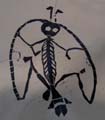
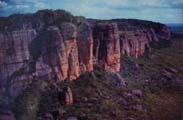
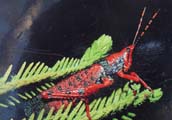
He wears his lightning as a band around him connecting his arms,
legs and-head.
Stone axes on his knees and elbows make the thunder.
Namarrgon now lives at Lightning Dreaming which can be seen from
Gunwarrde Warrde Lookout.
The actual lightning is his children, Aljurr (Aljurr means little
lightning).
Aljurr also have another form, that of a bright orange and blue
grasshopper, Leichhardt's grasshopper (Petasida ephippigera).
These grasshoppers come into the country during the early storm
season, when they are said to be looking for Namarrgon.
When Aboriginal people see these grasshoppers in the bush, they
know it is time to seek shelter.

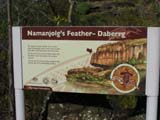
Gunwarrde Warrde Lookout also has its story:
"The distant solitary boulder is the feather which Namanjolg's
sister took from his headdress after they had broken the incest
laws.
She placed it here to show others what they had done. Later she
became the rainbow serpent."
At Nanguluwur Gallery some more interesting
explanations can be found.
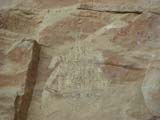
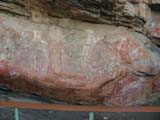
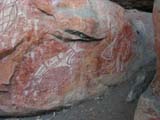
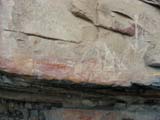
Change has always been a part of Aboriginal life but the greatest
changes have occurred since contact with European cultures.
Ships like this one were seen in the area between 1880 and 1950
when they brought supplies to buffalo hunting camps on the floodplains
of the Alligator Rivers, and returned to Darwin with hides.
Many Aboriginal people worked in these camps.
The work was seasonal, so people could return to their country
to carry out the cultural activities necessary to maintain spiritual
links with the land.
Aboriginal artists who choose to paint new subjects often pay careful
attention to detail perhaps to assist in story telling.
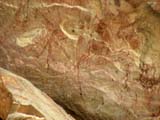
Look carefully high on the ceiling of the shelter for small paintings
of people.
These are examples of dynamic art, one of the oldest art styles
in the Park.
Boomerangs were used for hunting in the area about 20,000 years
ago when the climate was drier, and the land was covered with open
grasslands, similar to that around Tennant Creek today.
Boomerangs are of little use in the woodland forests growing nowadays
but are still used locally as clapping sticks to accompany music.
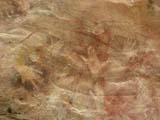
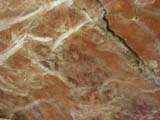
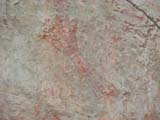
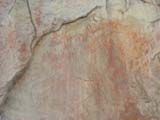
Hands have been the subject of rock art since Aboriginal people
first came to the area perhaps 50,000 years ago.
Notice the hands where the three middle fingers have been held
together and separated from the outer fingers compared with recent
stencils of hands and arms.
This style of hand stencil often occurs alongside "dynamic
art" estimated to be over 20,000 years old.
The decoration on these may have illustrated the lace gloves worn
by European women seen by the artist.
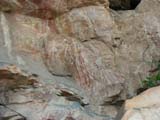

Algaihgo, the fire woman, is one of the First People or Nayuhyunggi
who created the world.
She planted the yellow banksias in the woodlands and used their
smouldering flowers to carry fire.
Stories about Algaihgo tell how she hunted rock possum, her favourite
food, with the help of the dingoes which travelled with her.
People are afraid of Algaihgo because she kills and burns people,
and avoid her Djang (sacred site) on the Arnhem Land Plateau where
her spirit lives.
Notice Algaihgo's four arms, and the banksias attached to her head.
Nayuhyunggi created the world and gave future generation laws
to live by.
Some took on human forms, others changed from humans to animals.
All have special powers.
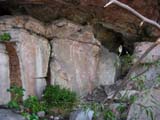
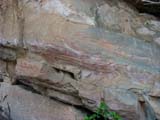
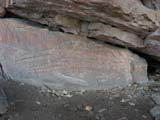
These Nayuhyunggi are called Namarnde.
They are invisible to ordinary people, live in caves and hollow
trees and come out at night.
They can entice people into their caves by calling them to come
closer.
People listening to the stories associated with this art are warned
that Namarnde eat human flesh. `
Notice their elongated toes and nipples.
Some have six fingers on each hand and carry dilly bags for their
victim's liver, lungs, heart and kidneys. |
































